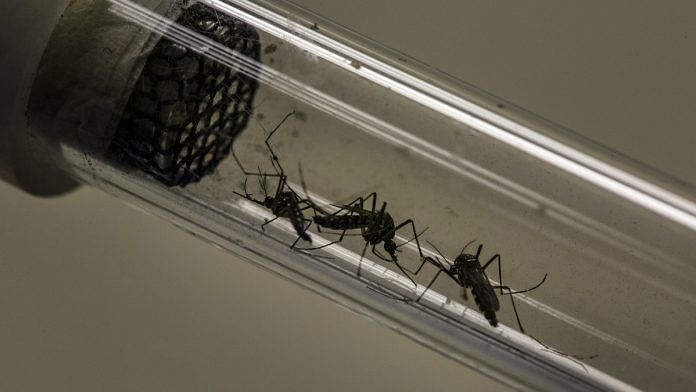New Delhi: The plains of Uttarakhand are reeling under a dengue outbreak, with a total of 2,600 cases reported since July. Of these, 1,788 or 68 per cent were reported from capital Dehradun, according to state health authorities.
Four of Uttarakhand’s six dengue deaths since July have been in Dehradun too.
The past 10 days have seen a sharp spurt in the number of dengue diagnoses in Dehradun: Until 5 September, the number stood at 712, but rose 151 per cent to 1,788 in the days since, according to the Dehradun chief medical officer (CMO).
“Last year, Dehradun registered 314 dengue cases. However, this year, out of a total 9,000 suspected cases of fever, we had confirmed 1,788 by Monday,” Dehradun CMO Dr S.K. Gupta told ThePrint.
“We are subjecting around 500-600 blood samples to the ELISA (enzyme-linked immunosorbent assay) test — an advanced test for confirming dengue — daily,” Gupta said.
Also Read: Mosquitoes kill more people every day than sharks do in a century
Other districts battling dengue
The figure of 2,600, from July until Monday, is nearly four times the number of dengue cases recorded by Uttarakhand in all of 2018 — 689.
Apart from Dehradun, Nainital (the lower areas), Haridwar, Udham Singh Nagar and Tehri Garhwal have also reported several dengue cases.
The total is 900 for Nainital alone. “Last year, we had reported around 600 cases but, this year, the cases are much more,” Nainital CMO Dr Bharti Rana said. “However, the good news is that we have already discharged around 800 patients and just one death has been reported.
Haridwar, an important Hindu pilgrimage site, has recorded 104 cases and zero deaths, a fall over last year. Last Wednesday, the district sent 30 blood samples for a dengue test and “to our surprise, all of them turned out positive”, Haridwar CMO Dr Saroj Naithani said.
“Last year, we registered 266 cases of dengue, so this year we are doing better. However, a strict vigil is important,” Dr Naithani added.
There have been 55 cases in Udham Singh Nagar, five in Almora and 15 in Tehri Garhwal since July.
Doctors conflicted over reasons
From climate change, misreported data to water shortage, Uttarakhand chief medical officers are offering up a host of possible reasons for the outbreak as they try to understand the massive spurt.
“The spurt in cases is probably due to climate change,” said Dehradun CMO Gupta. “Here (this year), we are receiving rainfall for a few minutes followed by harsh sunlight. This weather is probably better to breed dengue mosquitoes.”
The Nainital CMO, meanwhile, said he was flummoxed about why Haldwani has reported the majority of the district’s cases, while the neighbouring district of Udham Singh Nagar, with the same weather conditions, hasn’t witnessed as many.
“I am surprised… how their numbers are low and ours high. Haldwani has the same weather as Udham Singh Nagar. It could be due to misreporting or because we are more vigilant and performing more tests (hence diagnosing more patients),” added Dr Rana.
Udham Singh Nagar CMO Dr Shailaja Bhatt blamed the gap on the water shortage in Nainital. “I think the probable reason for more cases of dengue in Nainital is the shortage of water there. People in Nainital need to store more water than in US Nagar, where water is available in abundance.”
The World Health Organization describes dengue as “a mosquito-borne viral infection causing a severe flu-like illness and sometimes causing a potentially lethal complication called severe dengue”. The dengue carrier, the Aedes aegypti mosquito, is known to breed in water. That is why dengue prevention advisories often call for all stagnant water to be sprayed with kerosene, to keep mosquitoes at bay.
Also Read: India pays more than any developing country on funding R&D for dengue, malaria, HIV



